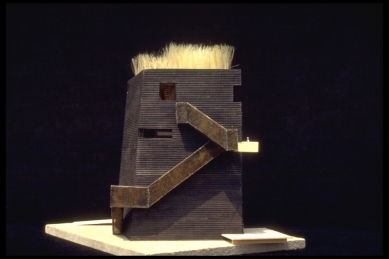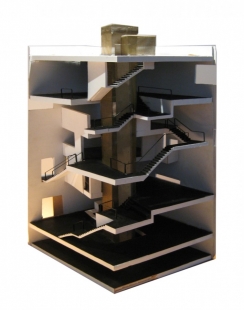
Knut Hamsun Center
<h1>Hamsunsenteret</h1>

 |
The 2700-square-meter Knut Hamsun Center includes exhibition areas, a library and reading room, a café, and an auditorium equipped with the latest film projection equipment. (Hamsun's writings have been particularly inspiring to filmmakers, which is evident in the more than 17 films based on his work.) The Knut Hamsun Center building is conceived as an archetypal and intensified compression of spirit in space and light, concretizing a Hamsun character in architectonic terms. The concept for the Knut Hamsun Center museum, “Building as a Body: Battleground of Invisible Forces,” is realized from inside and out. Here the wood exterior is punctuated by hidden impulses piercing through the surface: An "empty violin case" balcony has phenomenal sound properties, while a viewing balcony is like the "girl with sleeves rolled up polishing yellow panes."
Many other aspects of the Knut Hamsun Center building use the vernacular style as inspiration for reinterpretation. The stained black wood exterior skin is characteristic of the great wooden stave Norse churches. On the roof garden, long grass refers to traditional Norwegian sod roofs in a modern way. The rough white-painted concrete interiors are characterized by diagonal rays of light calculated to ricochet through the section on certain days of the year. These strange, surprising, and phenomenal experiences in space, perspective, and light provide an inspiring frame for Knut Hamsun Center exhibitions.
0 comments
add comment


















































